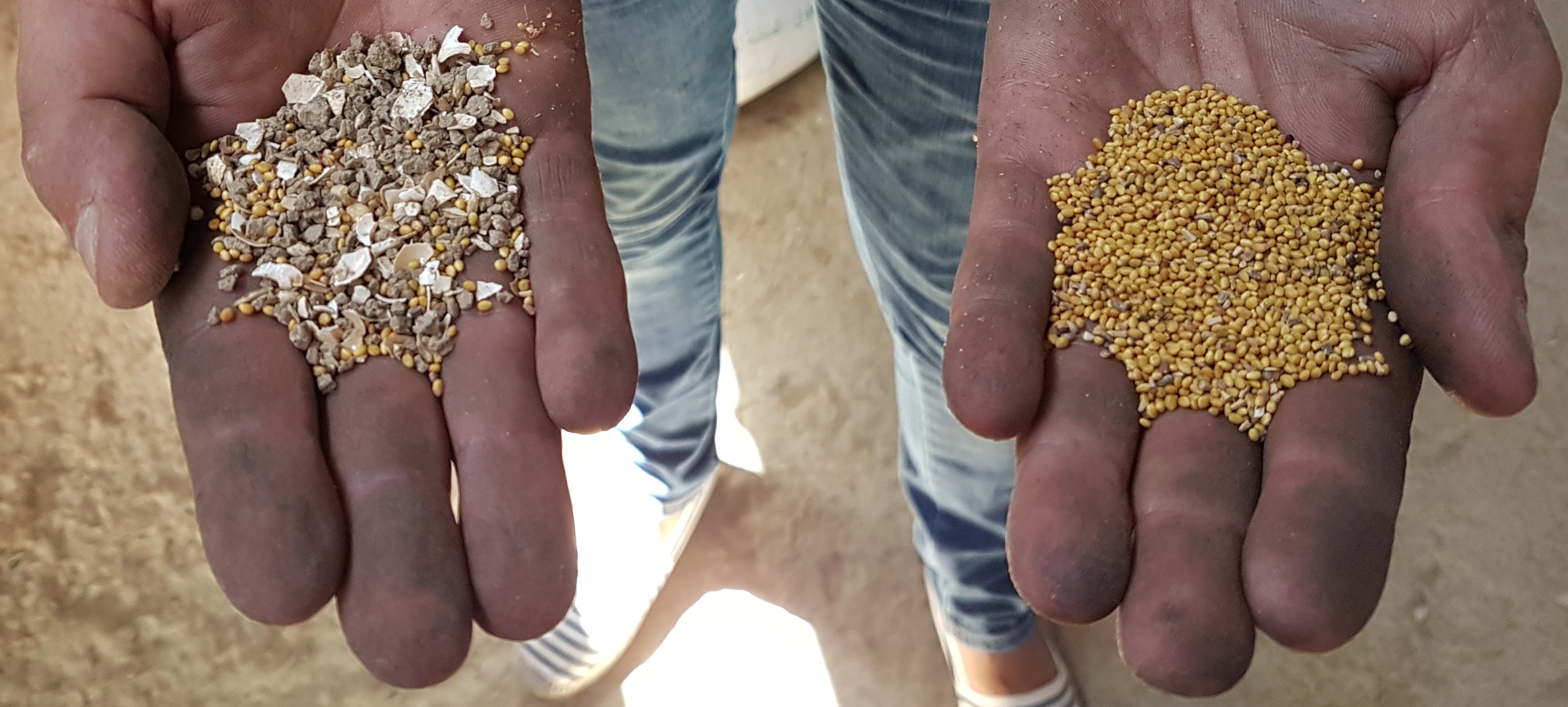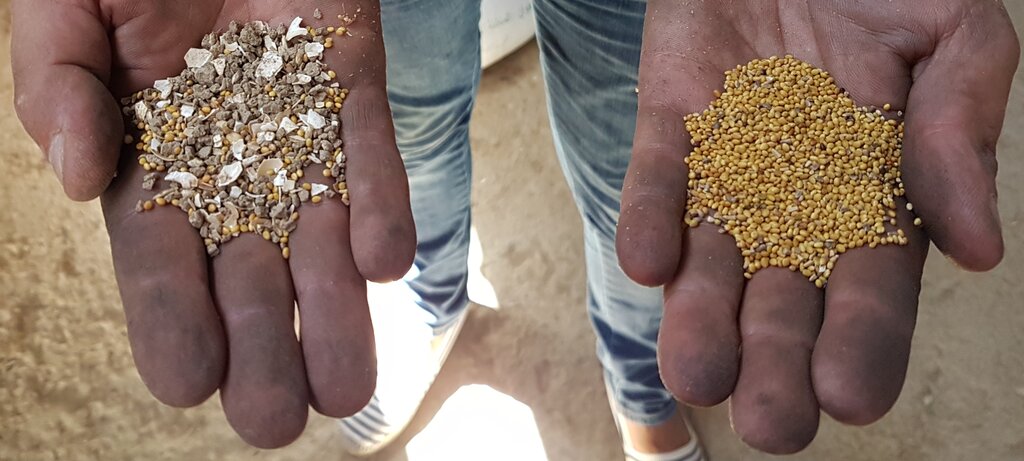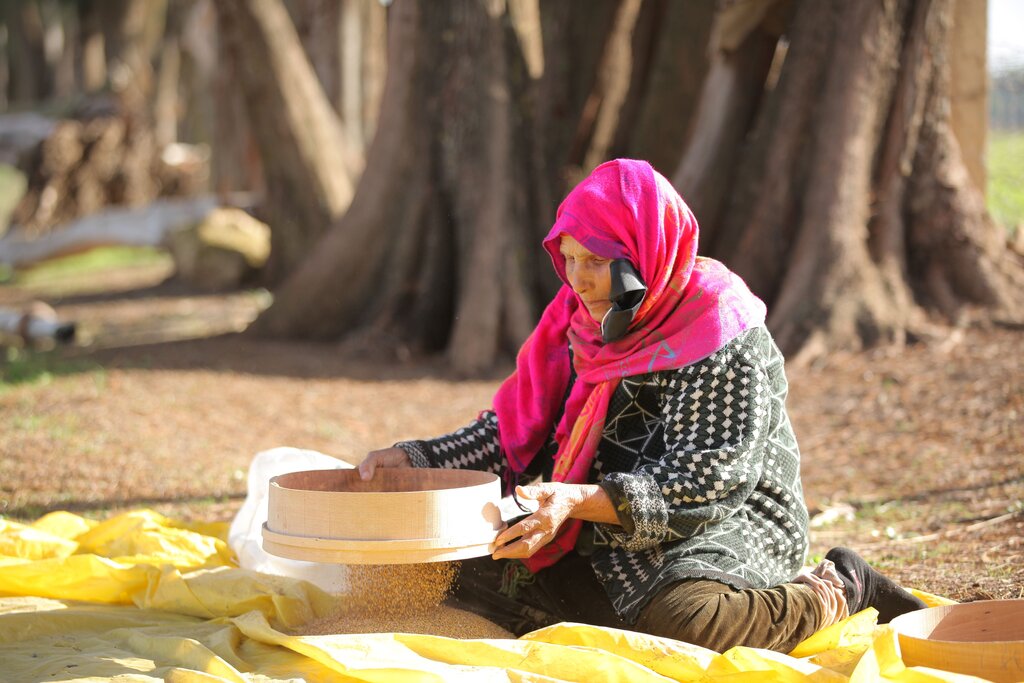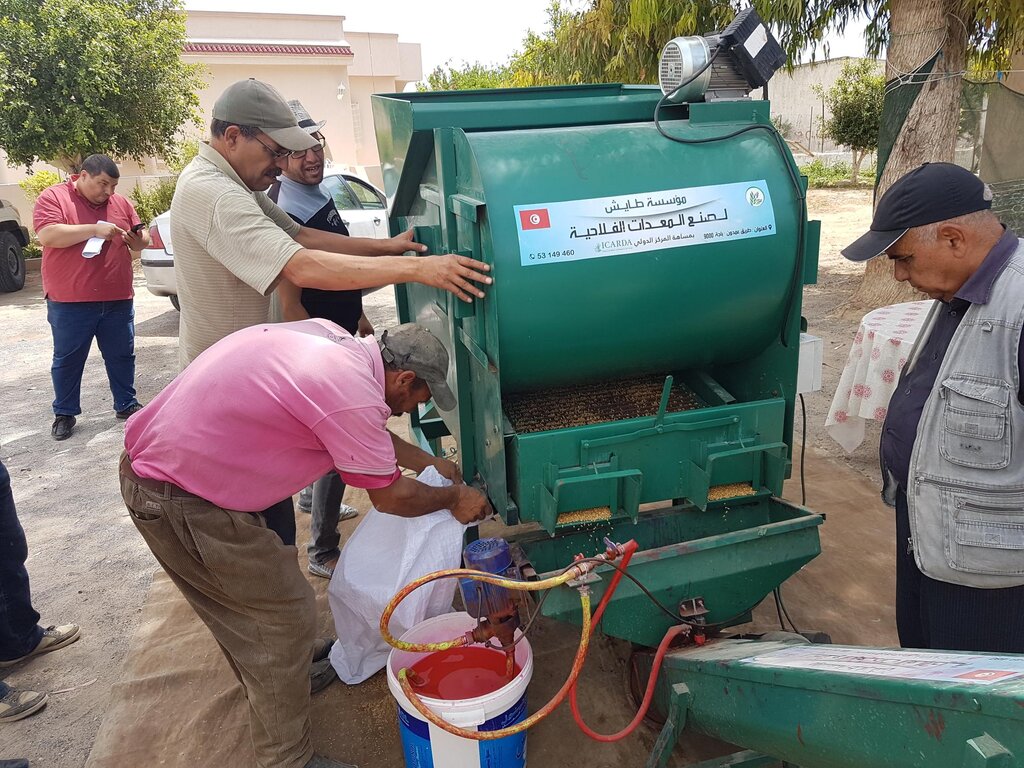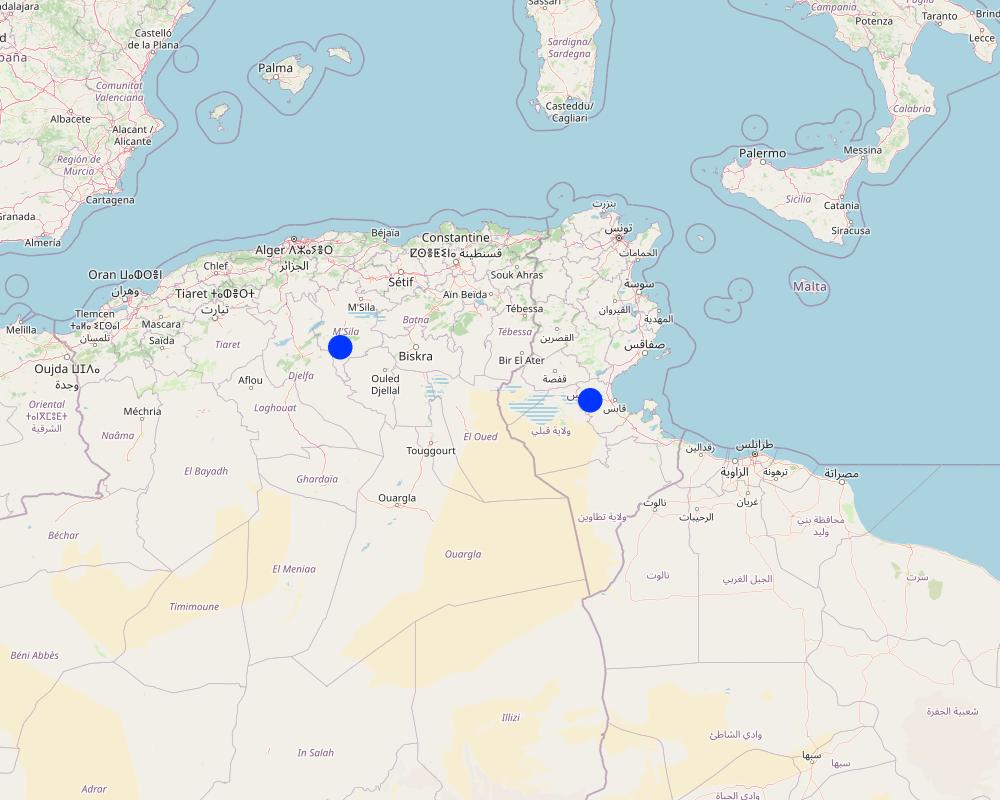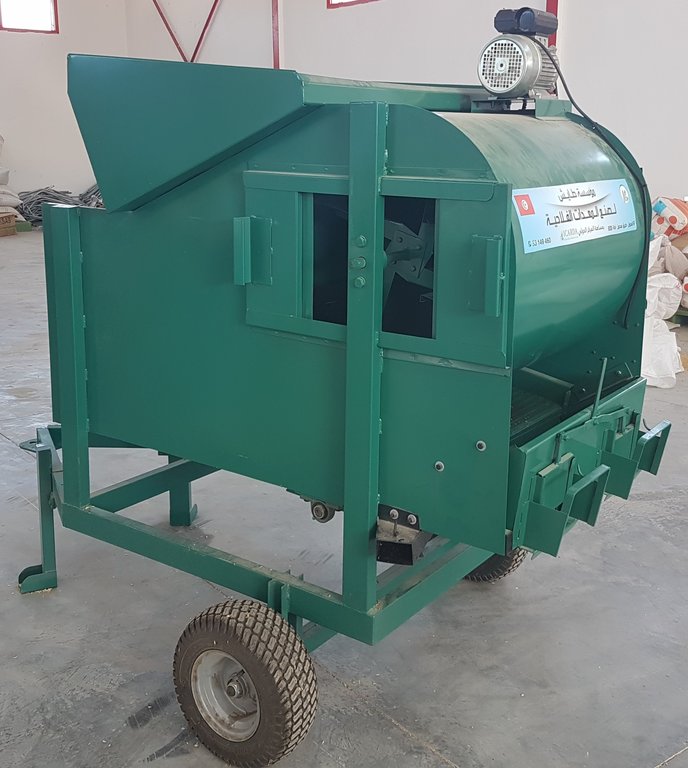Small-Scale Seed Cleaning Unit [Tunisia]
- Creation:
- Update:
- Compiler: Joren Verbist
- Editor: –
- Reviewers: William Critchley, Rima Mekdaschi Studer
technologies_6669 - Tunisia
View sections
Expand all Collapse all1. General information
1.2 Contact details of resource persons and institutions involved in the assessment and documentation of the Technology
Key resource person(s)
Agricultural Innovation Specialist:
Rudiger Udo
International Center of Agriculture Research in the Dry Areas (ICARDA)
Tunisia
Agricultural Economist:
Frija Aymen
International Center of Agriculture Research in the Dry Areas (ICARDA)
Tunisia
Economics and Participatory Methods:
Idoudi Zied
International Center of Agriculture Research in the Dry Areas (ICARDA)
Tunisia
Forage Specialist:
Zaiem Anis
Office de l'élevage et des pâturages (OEP)
Tunisia
Agricultural and Resource Economist:
Boubaker Dhehibi
International Center of Agriculture Research in the Dry Areas (ICARDA)
Tunisia
Senior Livestock Scientist:
Rekik Mourad
International Center of Agriculture Research in the Dry Areas (ICARDA)
Tunisia
Director of ITGC research station in Setif, Algeria:
Louahdi Nasreddine
Institut Technique des Grandes Cultures (ITGC)
Tunisia
Name of project which facilitated the documentation/ evaluation of the Technology (if relevant)
ICARDA Institutional Knowledge Management InitiativeName of the institution(s) which facilitated the documentation/ evaluation of the Technology (if relevant)
International Center for Agricultural Research in the Dry Areas (ICARDA) - Lebanon1.3 Conditions regarding the use of data documented through WOCAT
The compiler and key resource person(s) accept the conditions regarding the use of data documented through WOCAT:
Yes
1.4 Declaration on sustainability of the described Technology
Is the Technology described here problematic with regard to land degradation, so that it cannot be declared a sustainable land management technology?
No
1.5 Reference to Questionnaire(s) on SLM Approaches (documented using WOCAT)
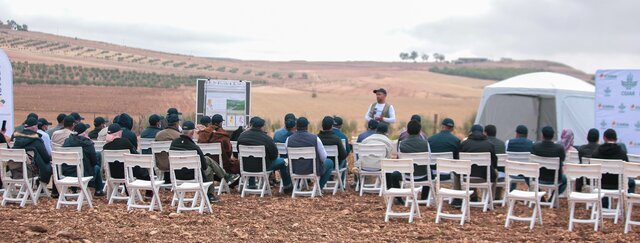
The 4-Wheels Approach for sustainable scaling [Tunisia]
The 4-Wheels Approach addresses the challenge of slow adoption of agricultural innovations among smallholder farmers by establishing Knowledge Hubs and partnerships with diverse stakeholders. The focus is on income-generating technologies and essential factors behind successful scaling up of innovations, ultimately driving agricultural modernization and sustainability.
- Compiler: Joren Verbist
2. Description of the SLM Technology
2.1 Short description of the Technology
Definition of the Technology:
The mobile seed cleaning machine improves the livelihoods of smallholder farmers in Tunisia by significantly enhancing seed quality, increasing crop production, reducing workload and costs, and promoting local value chains and social cohesion.
2.2 Detailed description of the Technology
Description:
In Tunisia and Algeria, the agricultural system is characterized by low levels of mechanization, particularly among small and medium-sized farmers who cannot afford expensive imported machines. As a result, a substantial amount of manual labour is required to carry out various agricultural operations, such as seed cleaning, which is traditionally done by women and children. While seed production is often done by large suppliers, this does not always satisfy the demand. Therefore, many smallholder farmers in Tunisia prefer to use their own seeds, despite the time-consuming manual cleaning process and the risk of lower quality.
To address these issues, the International Center for Agricultural Research in Dry Areas (ICARDA) collaborated with national partners to develop a mobile seed cleaning machine for small-scale farmers. The prototype, designed and tested with input from a local manufacturer, is suitable for the primary field crops (such as wheat, barley, vetch, and faba beans) in Tunisia. The machine sort out damaged or small seeds and rock or pebbles, while treating the remaining seeds by removing contamination or weeds, to ensuring quality and longer shelf-life.
The mobile seed cleaning machine, with a capacity of approximately 800 kilograms per hour depending on the seed type, was distributed to four farmer cooperatives, serving a total of 1,000 small-scale farmers. In order to promote ownership, the farmers contributed to a portion of the costs and received training on how to operate the machine effectively.
When using the mobile seed cleaning machine, farmers have the option to choose between two methods: solely cleaning the seeds or cleaning and treating them. The cost for cleaning alone is around 2 Tunisian Dinar per 100 kilograms, while the cost for both cleaning and treating, which includes the application of a fungicide, is 8 Tunisian Dinar per 100 kilograms. Life time is estimated between 5 and 10 years and worn out parts can easily be replaced.
The introduction of the mobile seed cleaning machine has several advantages, including a decrease in workload for women and children, improved production and quality of crops, higher productivity of the land, reduced dependence on imported seeds and machinery, and the promotion of local value chains and social cohesion through cooperative ownership and utilization of the machines.
However, there are still some challenges to overcome. For example, the initial prototype required heavy bags of seeds to be lifted to a height of two meters, leading to additional labour requirements and reduced efficiency. This challenge was addressed by equipping the machine with a conveyor screw, which can double its capacity at an additional cost. Additionally, the cost of purchasing the machine can be a significant investment for farmers, but this can be overcome through collective buying and organizing themselves in cooperatives.
In conclusion, the mobile seed cleaning machine represents an innovative solution that improves the (local) value chain and livelihoods of smallholder farmers in Tunisia by reducing workload and costs, particularly for women and children. This technology has the potential to be scaled up and benefit other regions and cooperatives.
ICARDA’s work on Small-Scale Seed Cleaning Unit is supported by the CGIAR Research Program on Livestock, the IFAD-Funded CLCA Project, the GIZ SWC@Scale project as part of the ProSol global program, and the CGIAR initiative on Agroecology in Collaboration with National Partners in Tunisia and Algeria (OEP-Tunisia, IRESA-Tunisia, INRAT Tunisia, ITGC-Algeria, GIZ Tunisie, DGACTA-Tunisie)
2.3 Photos of the Technology
2.5 Country/ region/ locations where the Technology has been applied and which are covered by this assessment
Country:
Tunisia
Specify the spread of the Technology:
- applied at specific points/ concentrated on a small area
Is/are the technology site(s) located in a permanently protected area?
No
Map
×2.6 Date of implementation
Indicate year of implementation:
2019
2.7 Introduction of the Technology
Specify how the Technology was introduced:
- during experiments/ research
- through projects/ external interventions
Comments (type of project, etc.):
see 2.2
3. Classification of the SLM Technology
3.1 Main purpose(s) of the Technology
- improve production
- create beneficial economic impact
- create beneficial social impact
3.2 Current land use type(s) where the Technology is applied
Land use mixed within the same land unit:
No

Grazing land
Extensive grazing:
- Semi-nomadic pastoralism
Intensive grazing/ fodder production:
- Cut-and-carry/ zero grazing
Is integrated crop-livestock management practiced?
Yes
If yes, specify:
Crops like barley, vetch and faba beans, are cultivated to feed livestock. The manure from livestock is used to fertilize the lands.
Products and services:
- meat
- milk
Species:
sheep
Species:
goats
3.3 Has land use changed due to the implementation of the Technology?
Has land use changed due to the implementation of the Technology?
- No (Continue with question 3.4)
3.4 Water supply
Water supply for the land on which the Technology is applied:
- mixed rainfed-irrigated
3.5 SLM group to which the Technology belongs
- energy efficiency technologies
- post-harvest measures
3.6 SLM measures comprising the Technology

agronomic measures
- A5: Seed management, improved varieties

structural measures
- S10: Energy saving measures

management measures
- M2: Change of management/ intensity level
3.8 Prevention, reduction, or restoration of land degradation
Specify the goal of the Technology with regard to land degradation:
- not applicable
4. Technical specifications, implementation activities, inputs, and costs
4.1 Technical drawing of the Technology
Technical specifications (related to technical drawing):
The seed cleaning machine has the following dimensions:
-Length = 180cm
-Width = 80cm
-Height = 175cm.
Equipped with a high-quality sieve measuring 140cm in length and 65cm in width, the seed cleaning machine ensures that even the smallest impurities are removed from the seeds. With a hopper capacity of 200kg, the machine can accommodate large batches of seeds, allowing for uninterrupted cleaning.
The machine has a cleaning capacity of around 600 till 1000kg/h.
Its lifetime is estimated to be between 5 and 10 years. Worn-out parts are easily replaceable and locally available.
4.2 General information regarding the calculation of inputs and costs
Specify how costs and inputs were calculated:
- per Technology unit
Specify unit:
100 kilogram cleaned and treated seed
other/ national currency (specify):
Tunisian Dinar
If relevant, indicate exchange rate from USD to local currency (e.g. 1 USD = 79.9 Brazilian Real): 1 USD =:
3.0
Indicate average wage cost of hired labour per day:
25
4.4 Costs and inputs needed for establishment
| Specify input | Unit | Quantity | Costs per Unit | Total costs per input | % of costs borne by land users | |
|---|---|---|---|---|---|---|
| Equipment | Seed cleaning machine with conveyor screw | 1.0 | 12500.0 | 12500.0 | ||
| Total costs for establishment of the Technology | 12500.0 | |||||
| Total costs for establishment of the Technology in USD | 4166.67 | |||||
4.6 Costs and inputs needed for maintenance/ recurrent activities (per year)
| Specify input | Unit | Quantity | Costs per Unit | Total costs per input | % of costs borne by land users | |
|---|---|---|---|---|---|---|
| Labour | Operating | person-hour | 0.1 | 10.0 | 1.0 | |
| Equipment | Electricity | kWh | 3.0 | 0.066 | 0.2 | |
| Plant material | Uncleaned seed | kilogram | 100.0 | |||
| Fertilizers and biocides | Fungicide (for treating) | litre | 0.2 | 30.0 | 6.0 | |
| Total costs for maintenance of the Technology | 7.2 | |||||
| Total costs for maintenance of the Technology in USD | 2.4 | |||||
Comments:
Farmers can choose to only clean or to also treat. Treating consists of applying fungicide as well. Farmers usually pay 2 TD/100kg for only cleaning and 8 TD/100kg for cleaning and treating.
Cleaning (and treating) 100 kilograms of seeds results in 70 kilogram of good useful seeds.
4.7 Most important factors affecting the costs
Describe the most determinate factors affecting the costs:
The costs of purchasing the machine is substantial. However, this should be shared among farmers within the cooperation.
5. Natural and human environment
5.1 Climate
Annual rainfall
- < 250 mm
- 251-500 mm
- 501-750 mm
- 751-1,000 mm
- 1,001-1,500 mm
- 1,501-2,000 mm
- 2,001-3,000 mm
- 3,001-4,000 mm
- > 4,000 mm
Agro-climatic zone
- semi-arid
5.2 Topography
Slopes on average:
- flat (0-2%)
- gentle (3-5%)
- moderate (6-10%)
- rolling (11-15%)
- hilly (16-30%)
- steep (31-60%)
- very steep (>60%)
Landforms:
- plateau/plains
- ridges
- mountain slopes
- hill slopes
- footslopes
- valley floors
Altitudinal zone:
- 0-100 m a.s.l.
- 101-500 m a.s.l.
- 501-1,000 m a.s.l.
- 1,001-1,500 m a.s.l.
- 1,501-2,000 m a.s.l.
- 2,001-2,500 m a.s.l.
- 2,501-3,000 m a.s.l.
- 3,001-4,000 m a.s.l.
- > 4,000 m a.s.l.
Indicate if the Technology is specifically applied in:
- not relevant
Comments and further specifications on topography:
This innovation can be implemented in many different environments.
5.3 Soils
Soil depth on average:
- very shallow (0-20 cm)
- shallow (21-50 cm)
- moderately deep (51-80 cm)
- deep (81-120 cm)
- very deep (> 120 cm)
Soil texture (topsoil):
- medium (loamy, silty)
Soil texture (> 20 cm below surface):
- coarse/ light (sandy)
- medium (loamy, silty)
5.4 Water availability and quality
Ground water table:
5-50 m
Availability of surface water:
poor/ none
Water quality (untreated):
poor drinking water (treatment required)
Is water salinity a problem?
Yes
Is flooding of the area occurring?
No
5.5 Biodiversity
Species diversity:
- low
Habitat diversity:
- low
5.6 Characteristics of land users applying the Technology
Sedentary or nomadic:
- Sedentary
- Semi-nomadic
Market orientation of production system:
- mixed (subsistence/ commercial)
Off-farm income:
- 10-50% of all income
Relative level of wealth:
- poor
- average
Individuals or groups:
- individual/ household
- groups/ community
Level of mechanization:
- mechanized/ motorized
Gender:
- women
- men
Age of land users:
- middle-aged
- elderly
Indicate other relevant characteristics of the land users:
This innovation also affects the children of the land users because the children are often the ones who do the seed cleaning
5.7 Average area of land used by land users applying the Technology
- < 0.5 ha
- 0.5-1 ha
- 1-2 ha
- 2-5 ha
- 5-15 ha
- 15-50 ha
- 50-100 ha
- 100-500 ha
- 500-1,000 ha
- 1,000-10,000 ha
- > 10,000 ha
Is this considered small-, medium- or large-scale (referring to local context)?
- small-scale
5.8 Land ownership, land use rights, and water use rights
Land ownership:
- individual, not titled
- individual, titled
Land use rights:
- individual
Water use rights:
- communal (organized)
- individual
Are land use rights based on a traditional legal system?
Yes
5.9 Access to services and infrastructure
health:
- poor
- moderate
- good
education:
- poor
- moderate
- good
technical assistance:
- poor
- moderate
- good
employment (e.g. off-farm):
- poor
- moderate
- good
markets:
- poor
- moderate
- good
energy:
- poor
- moderate
- good
roads and transport:
- poor
- moderate
- good
drinking water and sanitation:
- poor
- moderate
- good
financial services:
- poor
- moderate
- good
6. Impacts and concluding statements
6.1 On-site impacts the Technology has shown
Socio-economic impacts
Income and costs
farm income
Comments/ specify:
Is improved due to better yields and no/less costs on purchased seeds
diversity of income sources
Comments/ specify:
Cleaned seeds could be sold
workload
Comments/ specify:
Mechanically cleaning substituted the manual cleaning (often done by women and children)
Socio-cultural impacts
food security/ self-sufficiency
situation of socially and economically disadvantaged groups
6.2 Off-site impacts the Technology has shown
Dependency on seed distributors
6.3 Exposure and sensitivity of the Technology to gradual climate change and climate-related extremes/ disasters (as perceived by land users)
Climate-related extremes (disasters)
Biological disasters
| How does the Technology cope with it? | |
|---|---|
| epidemic diseases | very well |
6.4 Cost-benefit analysis
How do the benefits compare with the establishment costs (from land users’ perspective)?
Short-term returns:
positive
Long-term returns:
very positive
How do the benefits compare with the maintenance/ recurrent costs (from land users' perspective)?
Short-term returns:
very positive
Long-term returns:
very positive
6.5 Adoption of the Technology
- 1-10%
Of all those who have adopted the Technology, how many did so spontaneously, i.e. without receiving any material incentives/ payments?
- 0-10%
6.6 Adaptation
Has the Technology been modified recently to adapt to changing conditions?
No
6.7 Strengths/ advantages/ opportunities of the Technology
| Strengths/ advantages/ opportunities in the land user’s view |
|---|
| Substantially reduced in workload. |
| Decreased costs, and decreased dependency on the seed market |
| Improved seed quality |
| Strengths/ advantages/ opportunities in the compiler’s or other key resource person’s view |
|---|
| Improved gender equality because women and children mostly did the seed cleaning. |
| The unit is mobile hence many farmers can use it. |
| The seed cleaner unit and produced seeds improve the value chain on a local level |
| The seed cleaner unit is used within a farmer organization, hence it improves the cohesion within this organization. |
| Using cleaned seeds increased the productivity of the land. |
6.8 Weaknesses/ disadvantages/ risks of the Technology and ways of overcoming them
| Weaknesses/ disadvantages/ risks in the land user’s view | How can they be overcome? |
|---|---|
| Entering uncleaned seeds (bags usually weigh between 30 and 50 kilograms) into the machine, which is a lift around 2 meters, is too difficult for one person so additional labour is required. | The newer machines have a conveyor screw, to transport seeds from the ground to the entry. It is estimated that this will double the capacity. |
| Investment is required | Organizing in cooperations so costs can shared |
7. References and links
7.1 Methods/ sources of information
- interviews with land users
- interviews with SLM specialists/ experts
- compilation from reports and other existing documentation
When were the data compiled (in the field)?
2023
7.2 References to available publications
Title, author, year, ISBN:
Rudiger, U., Zaiem, A., Idoudi, Z., Frija, A., Rekik, M. and Taher, A. 2021. Mobile seed cleaning and treatment unit improves forage seed quality and quantity and presents a successful business model for farmer cooperatives. Business Model Brief. Nairobi, Kenya: ILRI.
Available from where? Costs?
https://hdl.handle.net/10568/116748
Title, author, year, ISBN:
Aymen, F., Idoudi, Z., Rudiger, U. and Rekik, M. 2020. Collaboration between ICARDA projects and linkages to IFAD investment portfolio for enhancing seeds quality and forage production through entrepreneurship and farmers associations. Some examples from ICARDA activities in Tunisia. Lebanon: International Center for Agricultural Research in the Dry Areas (ICARDA)
Available from where? Costs?
https://repo.mel.cgiar.org/handle/20.500.11766/11134
Title, author, year, ISBN:
Rudiger, U. 2020. Report on small mobile seed treatment units for cooperatives in Tunisia
Available from where? Costs?
https://hdl.handle.net/20.500.11766/12323
Title, author, year, ISBN:
Udo Rudiger. (15/12/2020). Workshop with beneficiaries.
Available from where? Costs?
https://hdl.handle.net/20.500.11766/12556
Title, author, year, ISBN:
Frija, A., et al. 2022. Soil Protection and Rehabilitation of Degraded Soil for Food Security – ProSol: Towards the Effective Scaling of Soil and Water Conservation Technologies under Different Agroecosystems in North and Central West Tunisia – SWC@Scale/ProSol: Technical Progress Report/ January – August 2022. Beirut, Lebanon: International Center for Agricultural Research in the Dry Areas (ICARDA)
Available from where? Costs?
https://hdl.handle.net/20.500.11766/67835
Title, author, year, ISBN:
Idoudi, Z. 2020. Encouraging Entrepreneurship with Mobile Grinders and Seed Cleaning Machines
Available from where? Costs?
https://www.icarda.org/media/blog/encouraging-entrepreneurship-mobile-grinders-and-seed-cleaning-machines
Title, author, year, ISBN:
Idoudi, Z., Najjar, D., Rekik, M., Frija, A. 2022. Integrating Gender in the Use of Conservation Agriculture for Crop and Livestock System (CLCA). Beirut, Lebanon: International Center for Agricultural Research in the Dry Areas (ICARDA)
Available from where? Costs?
https://hdl.handle.net/20.500.11766/67126
Title, author, year, ISBN:
Rekik, M., Frija, A., Idoudi, Z. 2022. Overview of CLCA Main Achievements in NA and LAC Countries. Beirut, Lebanon: International Center for Agricultural Research in the Dry Areas (ICARDA)
Available from where? Costs?
https://hdl.handle.net/20.500.11766/68177
Title, author, year, ISBN:
Rudiger, U., Zaiem, A., Idoudi, Z., Frija, A., Rekik, M. and Taher, A. 2021. Mobile seed cleaning and treatment unit improves forage seed quality and quantity and presents a successful business model for farmer cooperatives. Business Model Brief. Nairobi, Kenya: ILRI
Available from where? Costs?
https://hdl.handle.net/10568/116748
Links and modules
Expand all Collapse allLinks

The 4-Wheels Approach for sustainable scaling [Tunisia]
The 4-Wheels Approach addresses the challenge of slow adoption of agricultural innovations among smallholder farmers by establishing Knowledge Hubs and partnerships with diverse stakeholders. The focus is on income-generating technologies and essential factors behind successful scaling up of innovations, ultimately driving agricultural modernization and sustainability.
- Compiler: Joren Verbist
Modules
No modules


